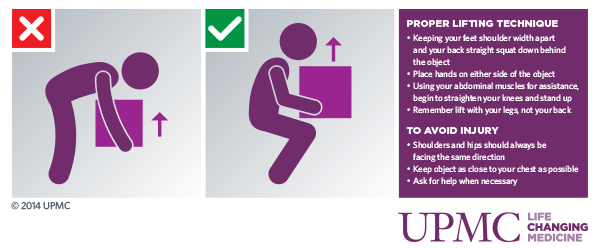With 30 million Americans experiencing back pain at any given time, it’s a common complaint from people of all ages. One of the most common causes of back pain is improper lifting techniques. Rushing to pick up an item or underestimating its weight can lead to back injuries.
Brian Caricato, DPT, regional director, UPMC Rehabilitation Institute, recommends following these steps to ensure proper lifting technique and help reduce the risk of injuring your back.
Never Miss a Beat!
Subscribe to Our HealthBeat Newsletter!
Thank you for subscribing!
You can now select the specific newsletters you'd like to receive.
You are already subscribed.
Subscribe to more newsletters in our email preference center.
Sorry, an error occurred. Please try again later.
Get Healthy Tips Sent to Your Phone!
Proper Lifting Technique
- Keeping your feet shoulder-width apart and your back straight, squat down behind the object.
- Place hands on either side of the object.
- Using your abdominal muscles for assistance, begin to straighten your knees and stand up.
- Remember to lift with your legs, not your back.
To avoid injury while lifting
- Your shoulders and hips should always be facing the same direction.
- Keep the object as close to your chest as possible.
- Ask for help when necessary.
Any time you do injure your back while lifting, follow these steps:
- Use heat or ice to relieve pain.
- Take one dosage of a pain reliever.
- Take it easy for a day or two.
- If pain persists longer than a week or is through your legs, contact your doctor.
If you are in serious pain, or if the pain lasts longer than a week, contact your doctor.
About UPMC Rehabilitation Institute
The UPMC Rehabilitation Institute offers inpatient, outpatient, and transitional rehabilitation, as well as outpatient physician services so that care is available to meet the needs of our patients at each phase of the recovery process. Renowned physiatrists from the University of Pittsburgh Department of Physical Medicine and Rehabilitation, as well as highly trained physical, occupational, and speech therapists, provide individualized care in 12 inpatient units within acute care hospitals and over 80 outpatient locations close to home and work.

